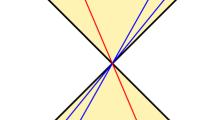Abstract
IN an earlier article1 it was pointed out that there is no foundation for the oft-repeated and generally believed statement that the rate of a moving clock is reduced by a certain factor compared with that of a similar stationary clock. The statement is baseless because in physics there is no explicit definition of a clock. A time-scale only is prescribed, and any instrument which records intervals agreeing therewith can legitimately be used as a clock. Three examples of such instruments were chosen, and it was shown that in no two of them was the ratio of the rates of stationary and moving clocks the same. It follows that, for any particular type of clock, this ratio (which, however, has no fundamental importance) can be determined only by taking into account the principle or the mechanism by which the clock operates. The familiar relativity transformation, , refers to the time-scale of physics, and can be logically deduced from the experimentally determined effect of motion on space measurement because the time-scale itself is defined in terms of space measurement: it is quite independent of the behaviour of moving clocks.
This is a preview of subscription content, access via your institution
Access options
Subscribe to this journal
Receive 51 print issues and online access
$199.00 per year
only $3.90 per issue
Buy this article
- Purchase on SpringerLink
- Instant access to full article PDF
Prices may be subject to local taxes which are calculated during checkout
Similar content being viewed by others
References
NATURE, 144, 888 (1939).
NATURE, 145, 427 (1840).
See "The Special Theory of Relativity" (Methuen's Monographs on Physical Subjects. In the press).
"The Philosophy of Physical Science" (Camb. Univ. Press).
Author information
Authors and Affiliations
Rights and permissions
About this article
Cite this article
DINGLE, H. The Rate of a Moving Clock. Nature 146, 391–393 (1940). https://doi.org/10.1038/146391a0
Issue date:
DOI: https://doi.org/10.1038/146391a0



